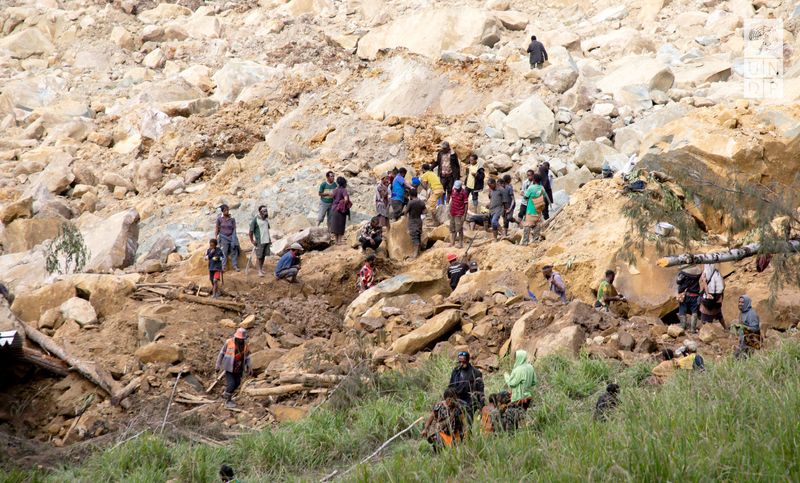Rescue teams don’t expect to find survivors in Papua New Guinea landslide
2024.05.30 00:24
By Lewis Jackson and Renju Jose
SYDNEY (Reuters) – Papua New Guinea ruled out finding survivors under the rubble of a massive landslide on Thursday, with the exact number of dead under almost two storeys of debris and mud still unknown but ranging from hundreds to thousands.
Heavy equipment and aid have been slow to arrive because of the treacherous mountain terrain, a damaged bridge on the main road, and tribal unrest in the area.
“No bodies are expected to be alive under the debris at this point, so it’s a full recovery operation to recover any human remains,” Enga province disaster committee chairperson Sandis Tsaka told Reuters.
Officials are still trying to pinpoint how many people are buried under parts of a mountain which collapsed onto the Yambali village in the Enga region around 3 a.m. last Friday.
Without a current census – the last credible one was done in 2000 – officials are relying on incomplete voter records and checks with local leaders to reach an estimate on total deaths.
More than 2,000 people may have been buried alive, according to the PNG government. A U.N. estimate put the death toll at around 670, while a local businessman and former official told Reuters it was closer to 160.
Tsaka said the government was still unsure about the death toll though it would be a “significant number.”
“It could be anywhere from hundreds to 2,000. I wouldn’t totally rule 2,000 out because of the uncertainty about how many people were (there) at the time but I can’t give you a definitive answer till we complete the social mapping,” he said.
Of the six bodies recovered so far, two lived outside the disaster area, Tsaka said, reinforcing officials’ view that there was lots of movement between communities.
Dozens of soldiers, engineers, geology experts and public health officials have reached the site, Tsaka said. Rescue teams are planning to use heavy machinery from Thursday, after unstable ground delayed its use earlier.
Thousands of residents are on alert for potential evacuation in case the landslide shifts further downhill.
“We are not even sleeping at night. We are afraid that more of the mountain will fall down and kill us all,” 20-year-old resident Frida Yeahkal told Reuters.
EPIDEMIC DANGERS
The landslide has buried nearby creeks and streams and contaminated the village’s primary water sources, posing a significant risk of disease outbreaks, the United Nations migration agency said in its latest update.
Most households lack alternative sources, such as rain catchment tanks, and there were no methods to treat water, further exacerbating drinking water shortages, it said.

The agency estimates about 1,650 people have been displaced, with one in five under the age of six.
“What will happen to the ones alive? I do not know where we will go for food and shelter. Our houses and gardens have all been destroyed,” community leader Yuri Yapara told Reuters.








